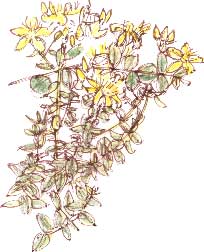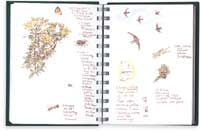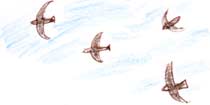
|
Healing HerbMonday, 28th July 2003, West Yorkshire |
![]()
![]()
![]()
![]() Rocks | History |
Workshop |
Links | Home
Page
Rocks | History |
Workshop |
Links | Home
Page
![]()

It's appropriate that St John's Wort should be growing here on a grassy bank by the car park at the Health Centre: 'wort' means a medicinal or pot herb and the healing properties of this plant were known to the Knights of St John at the time of the crusades. It was reputed to be so powerful that just to hang a bunch in your home on St John's Eve, 23rd June, would ward off evil spirits.
This species is common St John's wort also known as perforate St John's wort, Hypericum perforatum: what appear to be tiny pin-pricks in its leaf when you hold it up to the light (these days I can see these only with the aid of hand lens) were a clue to medieval herbalists that the plant had healing properties and could be used in the treatment of wounds.

![]()
![]() A
gatekeeper butterfly (a male, as you can tell by the
diagonal row of scent scales across the forewing) visits the flowers,
as does a small bumblebee and an orangey-ochre hoverfly.
A
gatekeeper butterfly (a male, as you can tell by the
diagonal row of scent scales across the forewing) visits the flowers,
as does a small bumblebee and an orangey-ochre hoverfly.
 A
large white butterfly flies with such a jerky action
that I can hardly make out the markings.
A
large white butterfly flies with such a jerky action
that I can hardly make out the markings.
![]() A
wolf spider runs across the tarmac at my feet. On closer
inspection I see that she's got her babies clustered on the back of her
abdomen.
A
wolf spider runs across the tarmac at my feet. On closer
inspection I see that she's got her babies clustered on the back of her
abdomen.
 A
grasshopper, in such a pale, washed-out greeny ochre
that it looks as if it's in desert camouflage, hops onto a grass stem.
A
grasshopper, in such a pale, washed-out greeny ochre
that it looks as if it's in desert camouflage, hops onto a grass stem.
 Swifts
screech overhead, dipping and diving over the rooftops and the neigbouring
back gardens and grassy open ground.
Swifts
screech overhead, dipping and diving over the rooftops and the neigbouring
back gardens and grassy open ground.

 A
few blackberries are starting to ripen.
A
few blackberries are starting to ripen.
![]()
![]() Next page | Previous page |
This day two
years ago | This month |
Nature Diary |
Home
Page
Next page | Previous page |
This day two
years ago | This month |
Nature Diary |
Home
Page
![]()